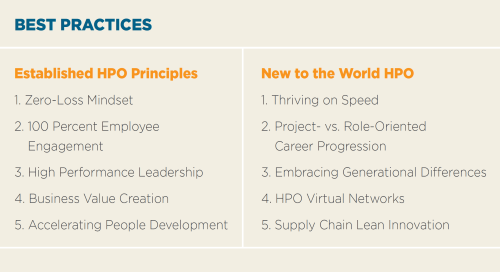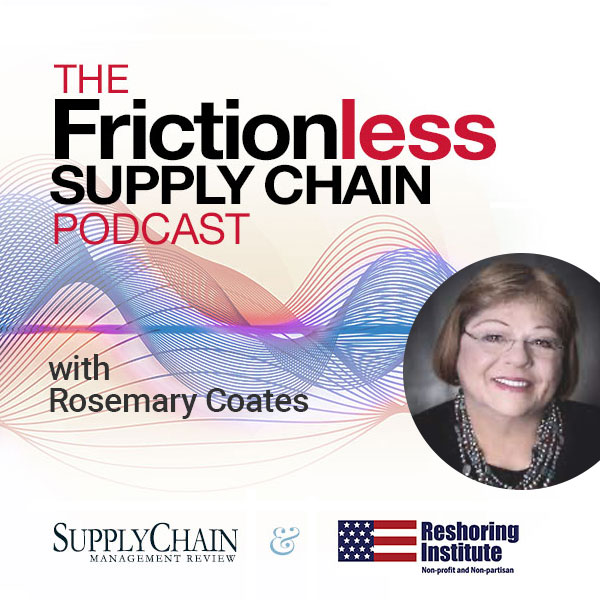This is the 6th of six articles on High Performance Organizations, or HPOs, based on research by the University of Tennessee, Knoxville’s Global Supply Chain Institute (GSCI). In the five preceding articles, we discussed how established, 1980s HPO principles play out in the modern business environment. We also detailed three new to the world HPO best practices we discovered in our research: Project Oriented Career Progression, Embracing Generational Differences and Virtual Networks. In this article, we’ll discuss the best practice with arguably the greatest competitive advantage — Thriving on Speed — and how the last best practice — Supply Chain Lean Innovation—enables it.

Today’s supply chains witness not only an increased magnitude of change. They see change occurring at a continually increasing speed. Generational shifts, digitalization, customer revolution, and consumer personalization have significantly changed supply chain culture and business requirements. Traditional supply chain organizations attribute organizational fatigue to this pace of change. But supply chains in High Performance Organizations (HPOs) harness these external dynamics to accelerate adoption of HPO principles and best practices and to motivate new Lean Innovation principles that power the company into the future.
Thriving on Speed: Traditional supply chain organizations can be overly reliant on management decision making, internally focused, and burdened by dated work processes, employee capabilities, and organization designs. These organizations do not have the time to meet today’s business requirements the way it has been traditionally done. Firefighting becomes the status quo, so and there is simply no time to proactively build capabilities that keep pace with the ever-shrinking cycles of work, action planning, continuous improvement, and innovation.
Many supply chain leaders say their biggest challenge to HPO is not the actual HPO journey but getting the organization to understand and embrace the need for change. Benchmark leadership helps their organizations see that they simply cannot keep up without adopting HPO elements such as 100 percent engagement, zero-defect mindset, external orientation, effective teamwork, continuous development, and employee empowerment. Leading supply chains begin their HPO journeys with external benchmarking like mapping their end-to-end (E2E) supply chain replenishment time, using simple Lean value mapping, and then contrast these maps with customers’ expectations (usually 3-4 day vs 100-200 day existing response times). They also measure the time required to bring different types of product innovations to market. With these metrics in hand, the organization quickly recognizes that time is indeed waste (Muda) and that solving for speed is a key to both business and personal success.
Supply Chain Lean Innovation: In the benchmark companies, Lean Innovation plays a key role in solving the problem of speed in operations such as manufacturing and distribution. Fast Kaizen prototyping, smaller teams of multiskilled, autonomous decision-makers, best-in-class solutions from different applications, diverse team membership, virtual design tools – all improve an organization’s ability to solve operational challenges quickly. Leadership’s foundation in this environment shifts from rules-based to principles-based to facilitate the entrepreneurship and experimentation.
Lean Innovation requires breakthroughs across all parts of the company, which can only be achieved through unconstrained thinking and E2E supply chain integration. With Lean Innovation, speed trumps department siloing, requiring strong multifunctional teamwork, diverse skills, and empowered front-line employees, all important HPO characteristics. Fast innovation requires organizational redesign, and these changes in culture and technology can only occur if there is a solid foundation of technical mastery, rigorous standards and a culture of continuous improvement already in place. Learning how to continuously improve the current, while planning for the discontinuous, is one of the most important characteristics of HPO leaders.
The pace of business is only increasing. Bemoaning traditional processes’ inability to keep up will leave companies out of business by 2025. Embracing the pace of change is arguably the first and best way to begin integrating HPO principles into every facet of the organization. New equipment must be designed with employee ownership, right the first time, and with speed in mind. Suppliers should be selected based on their ability to work seamlessly as supply chain partners. Changing customer and consumer requirements should be built into all product designs. Organization restructuring, employee upskilling, and supply chain synchronization should all be integrated into NPI financials. Digital investments should be made holistically, along with HPO work process and organization designs, to enable better, real time decision making, in empowered organizations that are as flat as possible.
Summary
This SCMR Series by the University of Tennessee, Knoxville’s Global Supply Chain Institute demonstrates that adopting HPO principles and best practices is essential given the technology explosion, consumer and customer needs fragmentation, and unprecedented pace of business and market changes. The HPO journey requires a new type of supply chain leadership to create the necessary conditions to meet changing market needs at a much faster pace than today. By focusing their energy on establishing an externally driven vision, and supporting their teams’ needs in achieving it, leaders tap into a broader pool of diverse, highly energized resources who will solve difficult issues and deliver breakthrough solutions much more quickly than a traditionally led organization.
You can read the other articles in the series by clicking on the link: Article 1; Article 2; Article 3; Article 4; and Article 5.
About the authors: Mike Burnette is a distinguished fellow at the Global Supply Chain Institute, University of Tennessee, Knoxville and a retired supply chain executive.
Mike Policastro is a researcher at the Global Supply Chain Institute, University of Tennessee, Knoxville and a retired supply chain executive.
About the Research: Research conducted by The University of Tennessee Global Supply Chain Institute reinforces the need for supply chain leaders to prioritize renewing “2025” high performance work systems (HPO) as a primary pathway to competitive advantage (Mike Burnette, Mike Policastro, Tim Munyon, “High Performance Organization Best Practices” – white paper University of Tennessee Haslam College of Business, 2019). An explanation of each best practice can be found in the GSCI white paper.
SC
MR

Latest Supply Chain News
- Planning fatigue may be settling in
- Inflation, economic worries among top supply chain concerns for SMBs
- April Services PMI declines following 15 months of growth, reports ISM
- Attacking stubborn COGS inflation with Digital Design-and-Source-to-Value
- Despite American political environment, global geopolitical risks may be easing
- More News
Latest Podcast

 Explore
Explore
Latest Supply Chain News
- Planning fatigue may be settling in
- Inflation, economic worries among top supply chain concerns for SMBs
- April Services PMI declines following 15 months of growth, reports ISM
- Attacking stubborn COGS inflation with Digital Design-and-Source-to-Value
- Despite American political environment, global geopolitical risks may be easing
- Joseph Esteves named CEO of SGS Maine Pointe
- More latest news
Latest Resources

Subscribe

Supply Chain Management Review delivers the best industry content.

Editors’ Picks





